
Camp Gitchigomee History
A Brief History of Camp Gitchigomee
In 1945, the Reverend Morse Goodman, Archdeacon Smedley, the Reverend Jennings and Mr. Irwin discovered our beautiful peninsula on the eastern shore of Sandstone Lake. The Diocese of Algoma, supported by Bishop Wright, purchased the property and welcomed the first campers that same summer.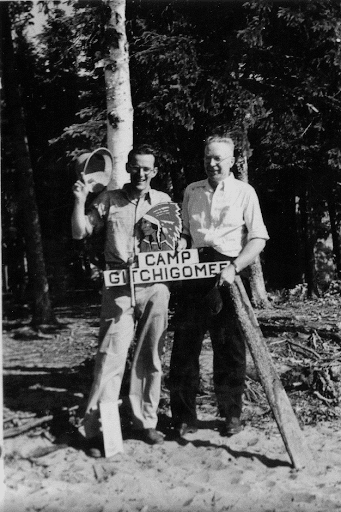
Clearing and building began in 1946 with 3 cabins built. Materials and supplies had to be carted, carried, pushed, pulled and back-packed for 2 & 1/2 miles over the former Port Arthur-Duluth Railroad bed. Road access was built later.
Smedley Lodge was built as the central multipurpose building, along with 2 cabins, in 1947. The rest of the Camp remained “under canvas” for several years, as facilities were gradually built. Today Smedley Lodge is our Dining Hall and Kitchen. Besides dining, the hall is also used for Bible Study and other group activities. As the story goes, the 2 X 6 walls of the Dining Hall were salvaged from grain storage buildings constructed on the waterfront during the Second World War. We still like to scrounge materials to use for building and repair. ☺
The Irwin family dedicated itself to construction of camp facilities and the third generation continued that tradition over 50 years later. Irwin Field was reclaimed slowly from the low wetland in the centre of the peninsula (not something that would be approved by MNR nowadays!). It was gradually built up with rocks, gravel and fill. It continues to be built up and maintained as a beautiful grassy field by recycling the natural debris from the beach.
The beach on Goodman Bay remains one of the finest in the area, with a long, shallow, sandy swim area, ideal for small campers. The large permanent docks of the 1950′s were no match for the ice conditions of northern winters. They were replaced by a floating dock which was permanently removed in the early 2000’s due to a deteriorated condition and the additional risks associated with its use.
The Camp Gitchigomee Ladies’ Auxiliary was formed in 1951 and has been instrumental in maintaining camp furnishings, buying craft and sports supplies, and in the very important role of providing bursaries to campers. Every spring these dedicated women went out to the Camp before it opens and clean every building to make it ready for the staff and campers. The women of each Anglican Church have been part of this labour of love over the years. By about 2010, the ladies found it too difficult to come out to camp to clean, but they hold an annual Bake sale, and donate the money to the camp for bursaries and general expenses.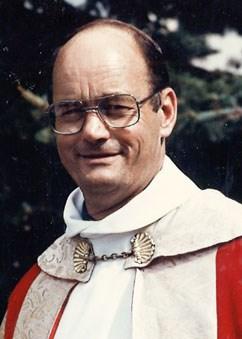
As Camp Director, Archdeacon Mark Conliffe dedicated 10 years to seeing the camp grow. He was a positive influence on many young Christian lives in the 1960′s and 1970′s. Every summer, he and his wife Enid and their family faithfully served at the camp. Conliffe Hall, built in 1965, is named after him. This building served originally as our recreation hall for crafts and indoor campfires. It now also serves as our chapel.
The Church of the Advent, once located in Hymers, was sold and money from that sale helped build the original log chapel. The altar from the church was moved into our log chapel, which became the symbol of the Camp until the 50th anniversary year. A sketch of the chapel, with its surrounding trees, was used on letterhead and t-shirts. The building, as it was later found, was built on wet land and the foundation gradually decayed to the point where the entire chapel had to be dismantled. The altar is now located in Conliffe Hall.
A tornado in 1978 damaged many of the buildings constructed over the previous 30 years. This event occurred, however, at a point when the Camp Board was discussing the need to upgrade. Improvements were made with the help of the insurance money and volunteer time. Three large cabins, Stewardson Manor, Bishop Nock Manor and Algoma Manor, were built to replace the smaller ones lost to the tornado.
Less “delicate”, but equally important as new housing, a 6-seater toilet facility was constructed. This facility remained the source of more than a few “smelly” jokes until our 50th year. In 1995, St. Paul’s Anglican Church undertook the project of converting the facility to flushies, obviously a significant event, if it made it into this history!
In about 1980, a Director’s cabin was constructed beside the lake, and furnished with a wood stove for those cool/cold days. In 2003, exterior siding and interior sheathing and insulation were installed. It was fitted with a lovely green steel roof in 2020. Rumour has it that this is the best place to have afternoon naps, on the bed beside the lake side window, and away from the generator! There is also a story among the locals that this building was broken in to during the winter by ice fishermen who got unexpectedly cold and wet and needed warm emergency shelter.
A new First Aid building was put up in 1990. The year before, many loads of gravel were put down at the site, and allowed to settle before building commenced. This method has proven very successful and preventing the heaving and settling from frost that happens annually on many other buildings! 2015 saw the removal of the by-then rotten deck and ramp, and replacement with steps and small landings at each of the two entrance doors. The bottom half of the exterior panelling was replaced in 2016.
In 1995 Camp Gitchigomee celebrated its 50th Anniversary. A special open house was held in June, with over 100 people visiting the Camp. A logo contest was conducted that spring, inviting children and adults to draft a new camp logo. There were two winners announced at the anniversary party: a mother and daughter, unbeknownst to each other, had submitted nearly identical logos. The Executive Committee decided to combine the two submissions into one logo, and so Barbara and Jessica Williams were both declared winners.
In 1997, the canoe shed was constructed with a side and garage doors and metal roof. In the summer, the canoes and paddles are removed for the summer – and put on the racks – and the building is used for crafts. Two of the interior walls are for craft supply storage.
1999 was the year that a new water filtration system was installed, entry gates put up, and a flagpole erected. Water was plumbed into the new custom – made Dining Hall wash-up sink which allowed the campers and staff to wash, rinse, sanitize and air dry dishes much easier. It can accommodate three people on each side – which helps foster teamwork, although there have been more than a few interesting interactions between campers involving water……
1999 also saw the fabrication of a large cedar cross, which was mounted on the south side of the Dining Hall. A hole was drilled in the bottom of the cross, which contains a glass tube which holds the names of all Intermediate campers and staff that attended this last year before the next millennium. As the story goes, the cross was put up by someone on an aluminum ladder, while a thunderstorm approached!
Speaking of weather, 1999 was the year of the “green sky”. On July 5, a massive system of high winds and small tornadoes came up from North Dakota and tracked across northern Ontario, and passed across the camp. Good thing there were no campers on site, as many trees came down, falling on the road out in between a staff car that was attempting to leave! Campers at the public campground came to the rescue with chain saws, as they thought there were children in the camp. A very harrowing experience!
In about 2000, a new 10 burner, two-oven stove was installed. While this may sound simple, it was not. Because the new stove was much wider than any doorway, part of the wall on the south side of the kitchen was cut out, which enabled the stove to come in from the back of a truck. Then someone had to be dispatched to the nearby landfill site to retrieve a critical fitting from the old burned-out stove to enable the new one to be hooked up. If you look carefully at this wall now, you might just be able to see where the wall was removed and subsequently patched up.
2002 saw the construction of Thomson Manor, in memory of the Rev. Canon Alvin Thomson. This staff house was a great addition, with two separate sides, and a door in between, to accommodate two families or one big one.
In 2004, the camp needed to comply with strict Ontario government requirements for supplying drinking water to vulnerable populations. (This came about from the Walkerton tragedy in May 2000.) For this reason, new water treatment system components were purchased and installed. It was subsequently upgraded two years later, and continues to provide safe drinking water at camp. The camp is required to have only trained persons operate the system, conduct daily checks, submit samples for analysis, keep records, and report any problems “forthwith” to various agencies. The water system was not installed in 2020 or 2021 because of the cancellation of the camps due to the COVID-19 pandemic.
In 2005, we celebrated our 60th anniversary with another great party and overnight camping. To mark this special year, we made interesting new “banners”. At the anniversary party, and at each of the camp weeks, we commemorated the milestone year on the tops of dining hall tables. The surfaces were sanded, each group designed, drew and painted a table-top mural and everyone signed it. Each table top was then sealed, creating a permanent record of the themes used, and the campers and staff who attended over the summer.
In the summer of 2007, our Tool Shed – one of the original camper buildings (there are still signatures on the ceiling) was in desperate need of a new floor, as it was completely rotten. It was jacked up, the rotten joists and flooring removed, while a new floor system was assembled then rolled under the building. It was an additional 6 feet longer, so that additional storage (now Tuck Shop) could be built the other end.
On December 7, 2007, after 63 years of operating as a Diocese of Algoma Deanery Bible camp, Gitchigomee was incorporated as a separate not for profit corporation. This was initiated a couple of years earlier by then Bishop Ferris to provide legal separation and protection for both the Diocese and the camp. The camp continues to be overseen by a ten member Board of Directors, one of whom is the Bishop of Algoma, who serves in an ex-officio capacity. In 2020, this position was delegated to Archdeacon Deborah Kraft.
Since the camp was no longer part of the Diocese, it was necessary to obtain a separate insurance policy. The first step necessary was to become accredited by the Ontario Camps Association. Once accredited, the camp obtained insurance from a separate insurance broker. Much of the work to get the accreditation involved establishing policies and procedures- which thankfully had been started by a dedicated volunteer a few years earlier. Still, there were a number of things that required upgrading and/or installation to meet the standards. A great team was able to accomplish all the steps necessary to meet the many criteria, and after the first standards visit in 2009, the camp received its accreditation. The camp also had successful accreditations in 2013, 2017, and 2023 (After delays related to COVID-19).
As the original Cook’s cabin became increasingly mouse-infested – in spite of valiant eradicating and cleaning efforts – it was torn down and replaced with a bigger one. The new 16 X 24 foot building began construction in 2008 and was completed in 2009. It has two sides; one for each of the Cook and Cookee.
2007 and 2008 also saw the erection of two 16 X 24 ft. shade shelters adjacent to the campfire pit. These structures provide shade on sunny hot days, and shelter during rain events. The end of sloped metal roof is also great for standing under and washing hair when the fire pump is discharged on it.
In 2009, the old “Cookee” cabin was moved (rolled, pushed, towed) across the field to its new location between Bishop Nock and a lifeguard cabin. This made room for Thomson Manor to be moved and evenly spaced between Stewardson Manor and the new Cooks cabin.
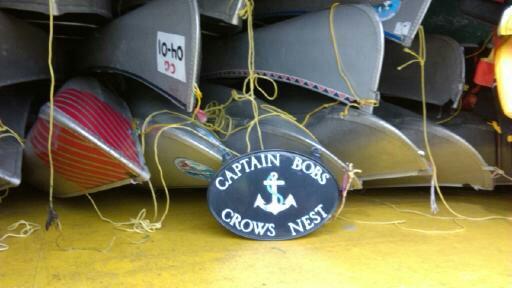 In June, 2011, the camp received a bequest of $50,000 from the estate of Captain Robert Lloyd. Captain Bob had a soft spot for children, and requested that the monies be used for the use and benefit of summer camp programs. This donation really helped us carry on this mission. Captain Bob also donated his “Captain Bob’s Crow’s Nest” sign he had received as a memento of his sailing days on the great Lakes. This sign proudly hangs on our Canoe Shed.
In June, 2011, the camp received a bequest of $50,000 from the estate of Captain Robert Lloyd. Captain Bob had a soft spot for children, and requested that the monies be used for the use and benefit of summer camp programs. This donation really helped us carry on this mission. Captain Bob also donated his “Captain Bob’s Crow’s Nest” sign he had received as a memento of his sailing days on the great Lakes. This sign proudly hangs on our Canoe Shed.
A bright new orange generator building was constructed in 2014, providing excellent protection for the electrical equipment and security to prevent unauthorized entry. It is also where electrical parts and wiring are stored for maintenance and upgrades. The metal frame for the original generator building was moved, re-purposed and re-clad as a “new” pump-house building down by the river. The old 30KW generator was sold to a Winnipeg contractor. Since 2002, a 15KW gen set has powered the camp, and was rebuilt in 2013 and 2021. An 8.5 KW gen set was donated in 2016 which provides back-up power, or power for rental groups where not as much power is required.
In the fall of 2016, a trusty crew removed the beam pieces under the lake side of the Dining Hall and replaced them with a single 48 foot laminated beam. The beam pieces under the opposite side of the building were also replaced with a laminated beam some time about 2011. New beams were also installed under the kitchen in 2017. 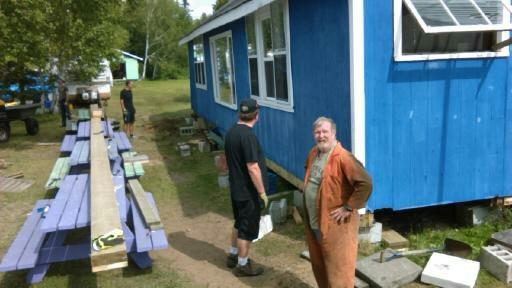
In 2017, a new south entrance deck was constructed, as was a new landing for the pantry entrance. The concrete steps in front of each of these entrances were “moved” together in front of the new Dining Hall south deck / entrance. The Dining Hall also received new double doors, with windows at both the south and north entrances.
2017 was also when a new used fireplace was installed in Conliffe Hall, replacing the [not exactly meeting code] acorn fireplace. The woodstove and chimney in the Director’s cabin was also brought up to code, thanks to Van Lenthe Mechanical. This was after rotten floor deck boards – from leaky chimney – were replaced.
A “Raise the Roof” campaign to replace the very worn-out shingles (circa 1985) on the Dining Hall and kitchen began in 2017. Great support was received, and the “Senior citizen’s roofing crew” and several others completed the work in 2018 and 2019. Many thanks to Chimo Lumber and DRD construction for their contributions as well. 2019 also saw the start of installing new 4 X 4 windows on the lake side of the Dining Hall, which were finished in 2021. To complete the work, metal siding was installed on the lake side of the Dining Hall; it was finished on November 8 when we lucked out with some really warm (shirt sleeve) weather.
In 2020, no summer camps were run, due to the COVID-19 pandemic. But this gave our property crew extra time to install a metal roof on Bishop Nock and the Director’s cabin, as was upgraded facia. The Biffies also got new shingles and facia, plus a paint job. The Canoe Shed looks quite lovely in its new green colour – which was a mixture of left-over paints! 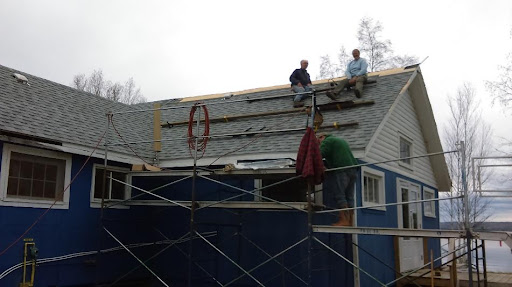
2021 also saw the suspension of children’s camps. Again, this extra time enabled us to install a metal roof on Algoma Manor (the last big cabin to have this done). Yay! We were blessed with a donation of a commercial stand-up mower – but then needed a place to store it. For that reason, we made a drive-through “mower port” on the east side of the Canoe shed, using up extra metal roofing from other projects. This year also saw the installation of a WETT-compliant wood stove in north-west corner of the Dining. This will be really great for those cool mornings and evenings.
Of course, all these upgrades to the site have made it possible to run summer camps for children all these years. We don’t have an official count, but expect that hundreds and hundreds – likely thousands have come to camp and been blessed. At its core, camp Gitchigomee provides opportunities for all who attend to draw near to the love of God through Jesus, and to be amazed at the wonders and joy of creation all around.
Over the years, many families, and groups have rented the camp and been blessed by their time there. Groups have included Anglican churches, and groups like the Deanery Youth retreat, the Soul of our Leaders retreat, other church denominations, the Navy League, Air Cadets, Confederation College, City of Thunder Bay, and others. There have been a number of family reunions and even a wedding!
Speaking of “visitors” to the camp, we have had our fair share of natural ones over the years at this beautiful setting: eagles, kingfishers, osprey, loons, ducks, woodpeckers and songbirds, moose, lynx, gophers, bear (off-season), fox, rabbits, snakes, mice, toads, frogs and a few mosquitoes ☺. Lots of bass lurk in the aquatic plants just beyond the swimming area.
As noted above, sadly, in 2020 and 2021, the children’s camps and our 75th anniversary plans had to be cancelled because of the COVID-19 pandemic. A great 75 +2 celebration was held the August long weekend in 2022 and children’s camps were heled again in 2023. We all felt especially blessed to be able to gather again together as a community after our time away, sharing storied about camp and re-connecting in worship.
The mission and ministry of the camp over these years could not have happened without the donations of time, talent and treasure by many, many volunteers and supporters. Huge thanks to all! Many of our helpers have received an Ontario Volunteer Service Award, given by the Ontario Government to recognize the tremendous work and commitment of volunteers. This is quite evident at Camp Gitchigomee, as many have received 5, 10, 20, 25, 30 and more year awards. Way to go!
